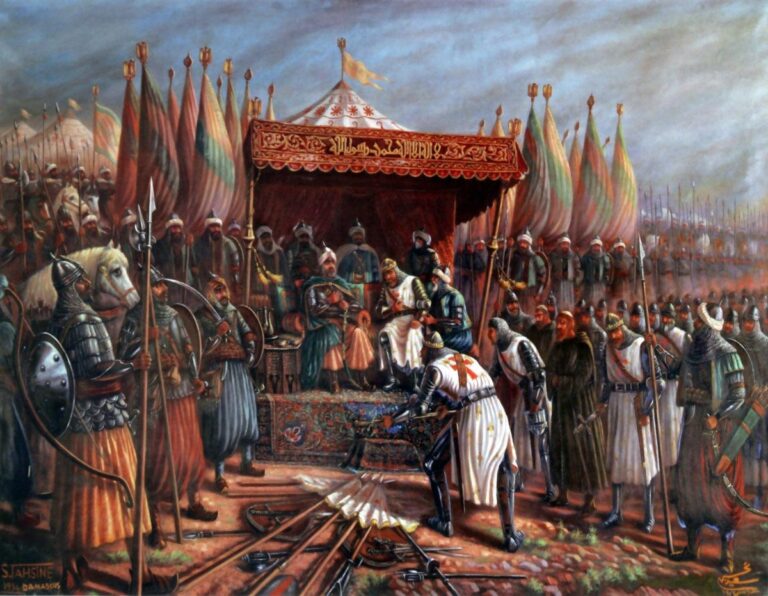In the decades leading up to 1187, Jerusalem had been under Crusader occupation. Following the First Crusade in 1099, the Crusaders established control over the holy city and surrounding regions, often with brutality. Muslim inhabitants were oppressed, Islamic sites were desecrated, and sacred lands were turned into strongholds of foreign rule.
But the tide began to turn when Salahuddin al-Ayyubi (Saladin) rose to leadership. A man of immense spiritual and political vision, Salahuddin spent years uniting fragmented Muslim territories, including Egypt, Syria, and parts of Iraq, into a single, disciplined front. His goal wasn’t just revenge. It was justice, rooted in faith and long-term strategy.
The Battle of Hattin: Breaking the Crusader Machine
On July 4, 1187, near the Horns of Hattin, a volcanic hill formation close to Lake Tiberias in present-day Palestine, Salahuddin’s army of approximately 30,000 men faced off against the Crusader forces led by King Guy of Jerusalem and the infamous Raynald of Châtillon.
The summer heat was fierce. Salahuddin used this to his advantage, cutting off the Crusaders’ access to water, forcing them into exhaustion and chaos. Surrounded, dehydrated, and demoralized, the Crusaders fell. Most of their knights were either killed or captured, effectively dismantling their military dominance in the region.
Notably, Raynald, known for attacking Muslim caravans and mocking the Prophet Muhammad ﷺ, was executed by Salahuddin himself, not out of vengeance, but as a matter of justice. King Guy was taken captive but spared.
The Fall of Jerusalem: A City Liberated with Mercy
With the Crusader army crushed, the path to Jerusalem lay wide open. Less than three months later, on October 2, 1187, Salahuddin entered the holy city not with bloodshed, but with compassion.
Unlike the Crusaders, who had massacred thousands of Muslims when they seized the city in 1099, Salahuddin granted safe passage to Christian civilians. He refused to desecrate churches, protected religious minorities, and offered a model of Islamic ethics in victory.
This wasn’t just a military win, it was a moral triumph, revealing the character of a leader driven by humility, not ego.
Why Hattin Still Matters Today
The Battle of Hattin wasn’t just a moment of historical importance; it was a turning point in the Islamic worldview. It reminds Muslims of what can be achieved when unity, patience, and purpose come together.
- Salahuddin didn’t win through rage or emotion but through strategic vision and spiritual discipline.
- He didn’t fight for personal glory, but for the revival of the Ummah.
- His leadership style, marked by humility, justice, and mercy, made him one of the most beloved figures in Islamic history.
In a world where disunity, apathy, and short-term thinking are rampant, Hattin is a timeless reminder that true change requires more than passion; it needs preparation, unity, and sincerity.
Lessons for Today’s Muslims
Victory doesn’t begin on the battlefield it begins within:
- Salahuddin’s triumph was years in the making, built on diplomacy, resilience, and internal reform.
- Muslims today must reflect: How can we unite our hearts and efforts before calling for external victories?
- True change is sustainable only when ethical leadership, community vision, and faith-driven action** guide us.
Salahuddin didn’t just wield the sword he revived the soul of a broken Ummah. And that’s why his legacy lives on.
July 4, 1187, was not just the date of a military battle. It was the moment the Muslim world remembered its strength not in numbers or weapons, but in its values.
The Battle of Hattin is not only history. It is a mirror reminding us what we could become if we choose to rise with unity, justice, and purpose once again.


